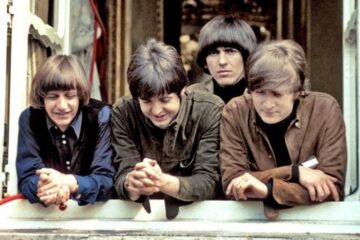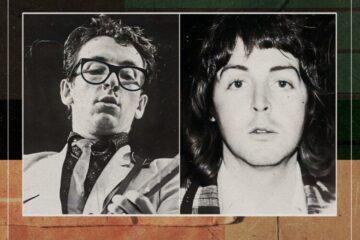News When William S. Burroughs interviewed Jimmy Page
When one considers the fact that some of the 20th century’s most prominent musicians, including John Lennon, Paul Mccartney, Bob Dylan, David Bowie, Thom Yorke and Kurt Cobain, cited Beat Generation literature as a pivotal influence on their songcraft, a scene in which Jimmy Page and William S. Burroughs converse enthusiastically shouldn’t be too difficult to envisage.
That said, when the American publication Crawdaddy asked Burroughs to attend a Led Zeppelin concert and interview guitarist Jimmy Page for a feature in 1975, the renowned Beat writer was hesitant. “I was not sure I could do it, not being sufficiently knowledgeable about music to attempt anything in the way of musical criticism or even evaluation,” Burroughs wrote in the eventual article.
As the above quote suggests, the Naked Lunch writer ultimately put his apprehensions to one side to humour this Led Zeppelin band all the young dudes were talking about. “I decided simply to attend the concert and talk with Jimmy Page and let the article develop,” he continued. “If you consider any set of data without a preconceived viewpoint, then a viewpoint will emerge from the data.”
Aged 61 at the time, Burroughs was a little out of touch with the latest music trends, but as a postmodernist writer and visual artist, it wasn’t quite akin to hurling one’s unsuspecting grandmother into a Five Finger Death Punch moshpit. He entered with an open mind, allayed by his pre-existing passion for heavy Moroccan horn music.
“So there we sat, I decline earplugs,” Burroughs wrote in his review of Led Zeppelin’s live show. “I am used to loud drum and horn music from Morocco, and it always has, if skillfully performed, an exhilarating and energizing effect on me. As the performance got underway, I experienced this musical exhilaration, which was all the more pleasant for being easily controlled, and I knew then that nothing bad was going to happen.”
“This was a safe and friendly area–but at the same time highly charged,” he continued. “There was a palpable interchange of energy between the performers and the audience, which was never frantic or jagged. The special effects were handled well and not overdone.”
“A few special effects are much better than too many,” Burroughs added, detailing the visual aspect. “I can see the laser beams cutting dry ice smoke, which drew an appreciative cheer from the audience. Jimmy Page’s number with the broken guitar strings came across with a real impact, as did John Bonham’s drum solo and the lyrics delivered with unfailing vitality by Robert Plant. The performers were doing their best, and it was very good. The last number, ‘Stairway to Heaven’, where the audience lit matches and there was a scattering of sparklers here and there, found the audience well-behaved and joyous, creating the atmosphere of a high school Christmas play.”
“All in all, a good show; neither low nor insipid. Leaving the concert hall was like getting off a jet plane,” Burroughs concluded.
After summarising Led Zeppelin’s energetic performance as reminiscent of the trance music he enjoyed while visiting Morocco, Burroughs appeared more confident heading into his conversation with Page. In his article, Burroughs noted that he preferred a conversation over a one-sided interview structure. “There is something just basically WRONG about the whole interview format,” he wrote.
Unbeknownst to Burroughs at the time, he and Page, 30 years his junior, had more in common than a taste for loud, rhythmic soundscapes. As an erudite artist, Page’s cultural references could overlap handsomely with those of Burroughs, who, himself, was no stick in the mud. Very quickly, it became apparent these two artists were both purveyors of darkness and uncompromising art.
As the pair sat down for a cursory cup of tea, they first bonded over mutual acquaintances. “The real estate agent who negotiated Jimmy Page’s purchase of the Aleister Crowley house on Loch Ness; John Michel, the flying saucer and pyramid expert; Donald Camel, who worked on ‘Performance’; Kenneth Anger, and the Jaggers, Mick and Chris,” Burroughs listed.
The conversation unravelled with a prominent focus on magic. “The subject of magic came up in connection with Aleister Crowley and Kenneth Anger’s film ‘Lucifer Rising’, for which Jimmy Page did the soundtrack,” Burroughs explained.
Of course, when artists as such discuss magic, one cannot expect optical illusions and cuff-borne flowers. Instead, they considered it a “magical interpretation of so-called reality”. Burroughs made a living in responding to the latent absurdity of life itself; in a literary sense, magic surrounds us from day to day if we’re prepared to accept it. Art can be found in everything and can have a vast, uncontrollable impact akin to a fission reaction.
“The underlying assumption of magic is the assertion of ‘will’ as the primary moving force in this universe–the deep conviction that nothing happens unless somebody or some being wills it to happen,” Burroughs explained. “To me, this has always seemed self-evident. A chair does not move unless someone moves it. Neither does your physical body, which is composed of much the same materials, move unless you will it to move. Walking across the room is a magical operation.”
In this premise, Burroughs betrayed a fear of art’s power to affect sociopolitical persuasions on a global scale. “With great Power comes great responsibility,” as Uncle Ben said to Peter Parker. “I found Jimmy Page equally aware of the risks involved in handling the fissionable material of the mass unconscious,” Burroughs wrote.
Burroughs recalled the story of a riot that started at a football match in Lima, Peru, in 1964. What began with a goal ended in tear gas, snarling dogs and “a sound like falling mountains” that echoed into the night.
This non-fictional parable didn’t elude Page, requiring any further explanation. “Yes, I’ve thought about that. We all have,” he replied, referring to his band. “The important thing is maintain a balance. The kids come to get far out with the music. It’s our job to see they have a good time and no trouble.”
“Of course, we are dealing here with meditation– the deliberate induction of a trance state in a few people under the hands of an old master. This would seem on the surface to have a little in common with a rock concert, but the underlying force is the same: human energy and its potential concentration,” Burroughs suggested to Page. He added that with deeply spiritual songs like ‘Stairway to Heaven’, Led Zeppelin had their hands on millions of young, malleable minds.
“There IS a responsibility to the audience,” Page responded. “We don’t want anything bad to happen to these kids–we don’t want to release anything we can’t handle.”
Burroughs then analogised the impact of Led Zeppelin’s countercultural presence with the stronghold of Christianity through the Dark Ages. “This ‘either/or’ straitjacket had been imposed by Christianity when all magic became black magic; that scientists took over from the Church, and Western man has been stifled in a non-magical universe known as ‘the way things are.’ Rock music can be seen as one attempt to break out of this dead soulless universe and reassert the universe of magic.”
Later, the pair addressed Led Zeppelin’s performance in a more superficial nature. Discovering a shared interest in trance music, the pair discussed the possibility of “synthesizing rock music with some of the older forms of trance music that have been developed over centuries to produce powerful, sometimes hypnotic effects on the audience.”
“Such a synthesis would enable the older forms to escape from the mould of folk lore and provide new techniques to rock groups,” Burroughs suggested.
The conversation also touched upon Led Zeppelin’s special effects, which Burroughs admired deeply in his review. “Lights, lasers, dry ice are fine–but you have to keep some balance,” Page commented. “The show must carry itself and not rely too heavily on special effects, however spectacular.”
Burroughs brought up the idea of infra-sound, physically affecting vibrations pitched below 16 Hertz that Professor Gavreau of France sought to weaponise for its potentially deadly effects. Burroughs suggested that, if used passively, it might be used for a more physical connection to music. Page was apparently very intrigued by the idea and gladly received a newspaper article on infra-sound that Burroughs handed him.
In another prominent cultural connection, the pair discussed Donald Cammell and Nicolas Roeg’s Mick Jagger-starring movie of 1970, Performance. Crucially, Burroughs noted that the screenwriters used the “cut-up” method that he and Brion Gysin popularised in the 1950s, wherein the writer reassembles once-lucid prose or verse to create an artistic collage.
“Musical cut-ups have been used by Earl Browne and other modern composers,” Burroughs noted. “What distinguishes a cut-up from, say, an edited medley is that the cut-up is at some point random. For example, if you made a medley by taking thirty seconds from a number of scores and assembling these arbitrary units–that would be a cut-up. Cut-ups often result in more succinct meanings, rather than nonsense.”
Whether or not Burroughs was correct in this assessment of the method, it certainly had a pivotal influence on word-based art over the late 20th century. Some of Page’s most prominent contemporaries, including Jagger, John Lennon and David Bowie, employed the cut-up technique to enhance some of their most celebrated compositions. Later, the same method was notably used by the likes of Kurt Cobain, Thom Yorke, and Michael Stipe, and it remains prominent in the arts to this day.
While Page deals in sound and Burroughs’ art was mostly visual, both had monumental respective impacts on the evolution of art over the late 20th century. So vast were these impacts that, over time, they have distorted and overlapped to birth culturally significant products such as Nirvana’s widely revered discography.
This rare conversation between Jimmy Page and William S. Burroughs marks one of those fateful and fruitful moments in pop cultural history that will forever seem much more than two blokes having a chinwag over a cuppa.




